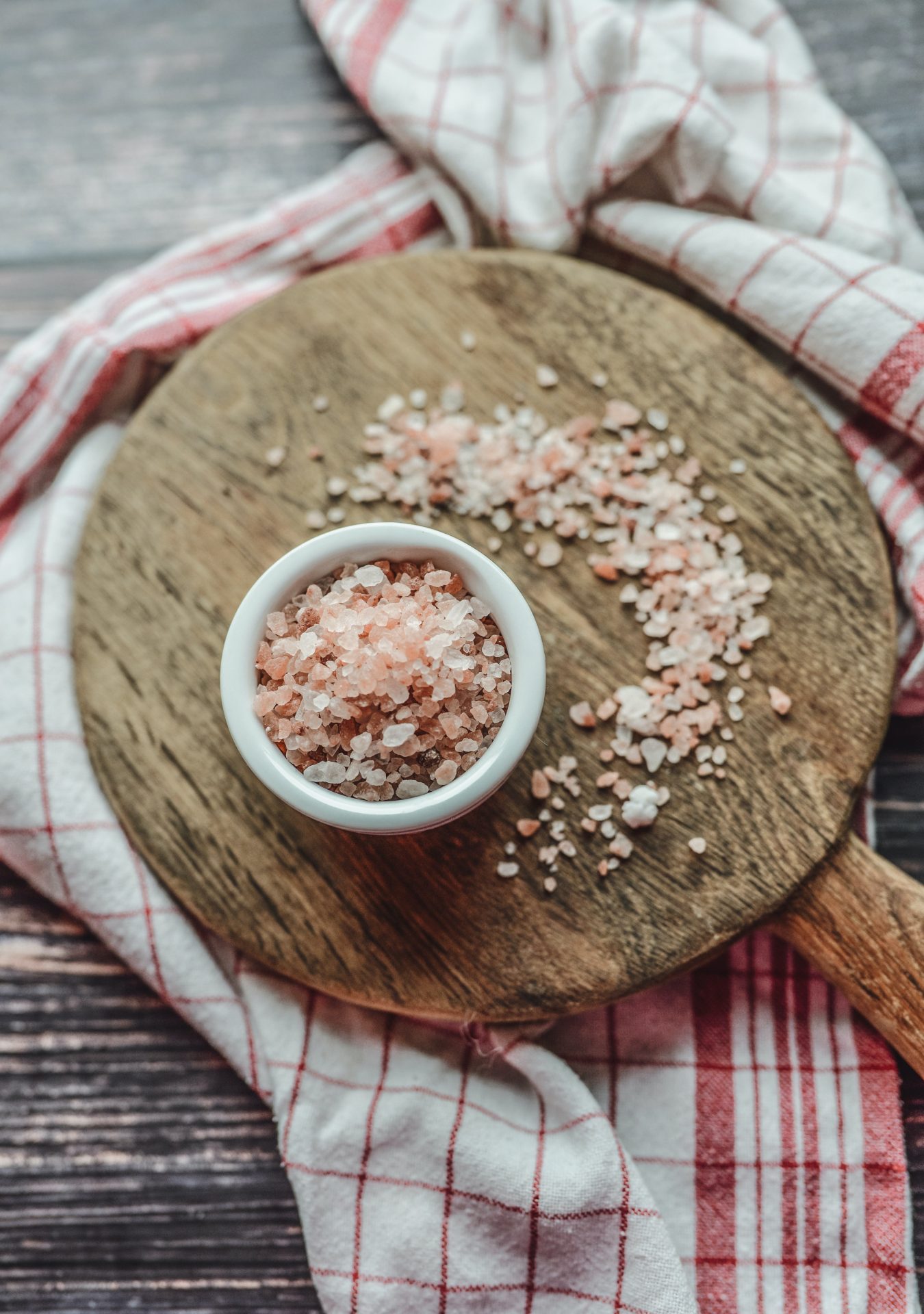If you’re a parent, you have likely heard that you shouldn’t add salt to food that you are offering to your baby. There are a number of reasons that have been given for this…
-
It can cause damage to their developing kidneys
-
It predisposes them to blood pressure issues later in life
-
It sets them up for strong salt preferences
But is this true? How much is too much? And what does the research actually show?
Before we get started it is important to note that we are certainly not recommending a high sodium diet for babies. However, it is always interesting to zoom out and reassess what we thought we knew, where there may be some gaps in the evidence and understanding, and how we can apply this information in a way that promotes health, reduces fear and ultimately makes feeding your family easier and more joyous.
Sodium vs salt… what’s the difference?
The terms salt and sodium are often used interchangeably, but they are not the same. Salt, which we use in our cooking and is added in large amounts to processed foods, is made up of sodium and chlorine. Sodium is a naturally occurring mineral that is essential to life. Sodium is found in many foods like milk (including breast milk and formula), eggs, meat, and vegetables.
As a rough guide:
1 teaspoon salt = 2,300 mg sodium
Current guidelines on sodium intake
There is not sufficient data to set an RDI (recommended dietary intake) for infant sodium intakes, so instead we are left with an AI (adequate intake) which is a bit of an estimate. Let’s look at the definition of an AI:
“The average daily nutrient intake level based on observed or experimentally-determined approximations or estimates of nutrient intake by a group (or groups) of apparently healthy people that are assumed to be adequate” (NHMRC 2017)
The Institute of Medicine elaborates that “for sodium, ‘nutrient adequacy’ refers to the sodium intake level at which one could consume a diet that basically meets all the recommended dietary intakes for other nutrients” (IOM 2007). So when we think about the “diet” that meets all the recommended dietary intakes of other nutrients for infants (0-6 months) – the food we are looking at is breastmilk or formula.
This creates an issue for the rest of the equation…
The exact composition of breastmilk is not fully understood. The micronutrient composition will fluctuate significantly, not just person to person, but throughout the day. Something that is acknowledged by researchers as a limitation when setting the AI for infants.
So how did they come up with the figures?
In Australia, the current recommendations for sodium in infants are (NHMRC 2017):
0-6 months – 120mg/day
7-12 months – 170mg/day
Did you know… in America the AI for infants 7-12 months is set at 370mg/day? More than DOUBLE the Australian recommendation (NAS 2019).
The following rationale is provided for how these guidelines were set:
“The AI for 0-6 months was calculated by multiplying together the average intake of breast milk (0.78 L/day) and the average concentration of sodium of 160 mg/L from the studies of Dewey & Lonnerdal (1983), Gross et al (1980), Keenan et al (1982), Lemons et al (1982), Morriss et al (1986) and Picciano et al (1981). The AI for 7-12 months was extrapolated from that for 0-6 months from a consideration of metabolic body weights and relative energy requirements” (NHMRC, 2017).
The main issue with this rationale is that the concentration of sodium in breastmilk fluctuates significantly. Studies have found the sodium content to be as low as 45mg/L, and as high as 1703mg/L with many variations in between (Javad et al. 2018, Allen et al. 1991, Richards et al. 2010, Yamawaki et al. 2005). The average is often sitting significantly higher than the current average used to set the AI (160 mg/L).
Sodium and kidney function
The body removes excess water by filtering blood through the kidneys. This requires a balance of sodium and potassium in the body. It has been thought that if a baby ingests too much salt, their kidneys may not be able to remove the high amounts of sodium and could therefore develop hypernatraemia (high blood sodium). But luckily, our bodies have a lot of back-up systems in place to keep sodium levels in our blood where they need to be. As you will soon read, hypernatraemia in children is rarely due to a high salt intake.
When looking at the current research on sodium and kidney function in infants, much of it centres around premature babies and their INCREASED need for sodium. A positive sodium balance is needed for a baby to grow.
It has been established that sodium requirements in the preterm infant are 69 to 115 mg/kg/day – a measure that is much higher than the AI for term infants from birth to 12 months of age (Koletzko et al. 2014). Hyponatraemia (or low sodium levels) is an area of concern in pre-term infants, and something that is closely monitored and supplemented to ensure adequacy and proper kidney function (Martin, 2022).
When analysing events of acute kidney injury in infants, again it was commonly hyponatraemia (low sodium) that was an issue – often due to excessive water intake (Mattoo, 2021).
It is important to acknowledge that sodium toxicity (hypernatraemia) is possible, but incredibly rare. The true incidence of this serious medical issue in children is unknown, and most reported events have been due to excess water loss/dehydration, gastroenteritis or systemic infection (Forman et al. 2012, Kaiser et al. 2011). There have been a few cases of hypernatraemia resulting from excessive salt intake, however the most frequently identified reasons were the use of salt water as an emetic and child abuse by the intentional administration of a high salt load by a caregiver (Su et al. 2010, Norma et al. 2020).
Sodium and blood pressure
The next point that is often given as a reason to avoid sodium in infants is the increased likelihood of high blood pressure later in life. While there are some studies that point towards this as a possibility, many of them are not robust in their methodology and acknowledge that the findings may be due to chance or other variables such as the early introduction of solids (before 4 months which is not recommended) (Brion et al. 2008). The studies also assume that the sodium content of breastmilk is static, which we know is not the case.
One study which compared the impact of sodium ingestion at 4 months, 8 months and 7 years on blood pressure found that while there did seem to be an increase in blood pressure at 7 years old in the group that ingested more sodium at 4 months, the same was not true when looking at sodium ingestion at 8 months and 7 years. It is also interesting that the higher sodium group at 4 months old were still consuming LESS than the recommended amount of sodium for this age group, suggesting that something else may have been contributing to the elevation in blood pressure. The researchers noted that “sodium intake at 8 months nor at 7 years was associated with systolic blood pressure at 7 years” despite the fact that “the majority of infants exceeded recommended levels of sodium intake at 8 months” (Brion et al. 2008).
The study also acknowledges that from around 4 months of age infants become more efficient at excreting sodium, so for those who commence solids at 6 months of age this potential issue is mitigated (Brion et al. 2008).
We are not denying that salt has an impact on blood pressure. While sodium consumption in infancy may not be correlated with higher blood pressure later in life, it can influence current blood pressure levels. Many studies have been conducted on dietary sodium intake and hypertension and the evidence strongly indicates that there is a direct relationship between sodium intake and elevated blood pressure in both adults and children (He et al, 2006). That said, when it comes to hypertension in infants and children, most will be as a result of underlying kidney disease, renovascular disease, or endocrine disease (Upsal et al. 2022). It is also important to note that data on what is “normal” blood pressure for this population is limited, and blood pressure is not routinely assessed, especially in young children.
Sodium and preference for salty tastes
So will offering salt to my child influence their food preferences later in life? It doesn’t seem to be the case. Research has shown that while children seem to have a higher preference for salty foods than adults, this liking for the salty taste does not seem to correlate with an increased consumption of salty foods (Liem 2017). It has also been proposed that some of the preference for the salty taste is actually correlated with the consumption of starchy carbohydrates and fast food, rather than the sodium in isolation (Liem 2017, Kim et al. 2009, Stein et al. 2012).
Interestingly, one study that compared the acceptance of a vegetable puree (plain with repeated exposure vs salted vs spiced) among toddlers, found that repeat exposure led to increased intake of the vegetable more so than the spiced group and even more again than the salt group! (Bouhlal et al. 2014).
Some researchers have hypothesised whether early life factors (mother’s morning sickness in utero, pre-term birth, low birth weight, early infancy gastrointestinal infection etc) may contribute to the preference for sodium as a protective and corrective mechanism (Stein et al. 2006, Leshem 1998), but this is not conclusive.
At this point in time the research does not really support the idea that exposure to salty foods early in life will predispose an infant to a preference for salty foods later in life.
So what does this mean for your family?
It is not at all our intention to recommend a high sodium diet for infants. While there are some gaps in the current research and understanding, it is still advisable to approach feeding your infant with care, common sense and a degree of caution – particularly in those who choose to commence solids prior to 6 months of age. We recommend that as much as possible babies and young children are fed a minimally processed whole food diet, with a focus on fresh vegetables and fruit, quality protein and fat sources as well as iron rich foods offered in a way that is appropriate for your family.
If your family consumes a lot of fast food or processed foods then you want to be aware of the sodium levels in these foods and offer something more appropriate for your child. Research has found that children are consuming the majority of their sodium intake from processed and ultra processed foods, not from home cooked foods that have been seasoned with moderate amounts of salt (Quader et al. 2017, O’Halloran et al. 2016). In fact, the 2011-12 Australian Health Survey analysed the proportion of sodium that comes from the diet. For the population aged 2 years and older, cereals and cereal based products contributed 43% of dietary sodium (ABS 2014).
If you primarily make your food from scratch, you can confidently add some salt to your cooking without needing to be hypervigilant. That’s not to say you should go crazy with the amount of salt added, but a regular amount to taste is fine. This will make mealtimes easier because you can confidently offer your little one the same food as the rest of the family.
As with everything health related, there are nuances, so if you have any queries or health history that feels concerning, please seek individual guidance from your primary healthcare provider.
WRITTEN BY:
Kate Holm (Naturopath & Nutritionist)
REVIEWED BY:
Luka McCabe (RN/RM/Nutrition Consultant)
Renee Jennings (Dietitian and Nutritionist, APD)
REFERENCES
Australian Bureau of Statistics, 4364.0.55.007 – Australian Health Survey: Nutrition First Results – Foods and Nutrients, 2011-12. 2014: Canberra
Allen, Jonathan C., et al. “Studies in human lactation: milk composition and daily secretion rates of macronutrients in the first year of lactation.” The American journal of clinical nutrition 54.1 (1991): 69-80.
American Academy of Pediatrics Committee on Nutition. Appendix A: Composition of human milk. In: Pediatric Nutrition, 8th ed, Kleinman RE, Greer FR (Eds), American Academy of Pediatrics, 2014. P.1505.
Bouhlal S, Issanchou S, Chabanet C, Nicklaus S. ‘Just a pinch of salt’. An experimental comparison of the effect of repeated exposure and flavor-flavor learning with salt or spice on vegetable acceptance in toddlers. Appetite. 2014 Dec;83:209-217. doi: 10.1016/j.appet.2014.07.032. Epub 2014 Aug 27. PMID: 25171850.
Brion, MJ., Ness, A., Davey Smith, G. et al. Sodium intake in infancy and blood pressure at 7 years: findings from the Avon Longitudinal Study of Parents and Children. Eur J Clin Nutr 62, 1162–1169 (2008). https://doi.org/10.1038/sj.ejcn.1602837
Feng J. He and Graham A. MacGregor, Importance of Salt in Determining Blood Pressure in Children, Meta-Analysis of Controlled Trials, 25 Sep 2006, Hypertension. 2006;48:861–869, https://doi.org/10.1161/01.HYP.0000245672.27270.4a (accessed 02.12.22)
Forman S, Crofton P, Huang H, Marshall T, Fares K, McIntosh N. The epidemiology of hypernatraemia in hospitalised children in Lothian: a 10-year study showing differences between dehydration, osmoregulatory dysfunction and salt poisoning. Arch Dis Child. 2012 Jun;97(6):502-7. doi: 10.1136/archdischild-2011-300305. Epub 2012 Apr 3. PMID: 22493405.
Institute of Medicine. 2007. Dietary Reference Intakes Research Synthesis: Workshop Summary. Washington, DC: The National Academies Press. https://doi.org/10.17226/11767.
Javad, Masoumeh Taravati, et al. “Analysis of aluminum, minerals and trace elements in the milk samples from lactating mothers in Hamadan, Iran.” Journal of Trace Elements in Medicine and Biology 50 (2018): 8-15.
Kaiser P, Borte M, Zimmer KP, Huppertz HI. Complications in hospitalized children with acute gastroenteritis caused by rotavirus: a retrospective analysis. Eur J Pediatr. 2012 Feb;171(2):337-45. doi: 10.1007/s00431-011-1536-0. Epub 2011 Aug 11. PMID: 21833497.
Kim GH, Lee HM. Frequent consumption of certain fast foods may be associated with an enhanced preference for salt taste. J Hum Nutr Diet. 2009 Oct;22(5):475-80. doi: 10.1111/j.1365-277X.2009.00984.x. PMID: 19743985.
Koletzko B, Poindexter B, Uauy R (Eds), Karger, Nutritional Care of Preterm Infants: Scientific Basis and Practical Guidelines, 2014.
Leshem M. Salt preference in adolescence is predicted by common prenatal and infantile mineralofluid loss. Physiol Behav. 1998 Feb 15;63(4):699-704. doi: 10.1016/s0031-9384(97)00525-8. PMID: 9523918.
Liem DG. Infants’ and Children’s Salt Taste Perception and Liking: A Review. Nutrients. 2017 Sep 13;9(9):1011. doi: 10.3390/nu9091011. PMID: 28902163; PMCID: PMC5622771.
Martin, Camilla, 2022 “Nutritional composition of human milk and preterm formula for the premature infant”, Up To Date, https://www.uptodate.com/contents/nutritional-composition-of-human-milk-and-preterm-formula-for-the-premature-infant (accessed 11.11.22)
National Academies of Sciences, Engineering, and Medicine. Dietary Reference Intakes for sodium and potassium. National Academies Press, 2019.
National Health and Medical Research Council. Eat For Health. Nutrient Reference Values for Australia and New Zealand, Sodium, 2017 https://www.eatforhealth.gov.au/nutrient-reference-values/nutrients/sodium (accessed 11.11.22)
Neil G Uspal, MD, Susan M Halbach, MD, George A Woodward, MD,Bruder Stapleton, MD, James F Wiley, II, MD, Laurie Wilkie, MD, Approach to hypertensive emergencies and urgencies in children, Up To Date, Oct 12, 2022, https://www.uptodate.com/contents/approach-to-hypertensive-emergencies-and-urgencies-in-children (accessed 02.12.22)
Norma A. Metheny, Mary M. Krieger, 2020, “Salt Toxicity: A Systematic Review and Case Reports”, Journal of Emergency Nursing, Volume 46, Issue 4, Pages 428-439, ISSN 0099-1767, https://doi.org/10.1016/j.jen.2020.02.011.
O’Halloran SA, Grimes CA, Lacy KE, Nowson CA, Campbell KJ. Dietary sources and sodium intake in a sample of Australian preschool children. BMJ Open. 2016 Feb 4;6(2):e008698. doi: 10.1136/bmjopen-2015-008698. PMID: 26846894; PMCID: PMC4746469.
Pietrzak-Fiećko R, Kamelska-Sadowska, The Comparison of Nutritional Value of Human Milk with Other Mammals’ Milk, Nutrients. 2020;12(5) Epub 2020 May 14.
Quader ZS, Gillespie C, Sliwa SA, Ahuja JK, Burdg JP, Moshfegh A, Pehrsson PR, Gunn JP, Mugavero K, Cogswell ME. Sodium Intake among US School-Aged Children: National Health and Nutrition Examination Survey, 2011-2012. J Acad Nutr Diet. 2017 Jan;117(1):39-47.e5. doi: 10.1016/j.jand.2016.09.010. Epub 2016 Nov 3. PMID: 27818138; PMCID: PMC5458522.
Richards, Anna A., et al. “Breast milk sodium content in rural Gambian women: between and within women variation in the first 6 months after delivery.” Paediatric and perinatal epidemiology 24.3 (2010): 255-261.
Stein LJ, Cowart BJ, Beauchamp GK. The development of salty taste acceptance is related to dietary experience in human infants: a prospective study. Am J Clin Nutr. 2012 Jan;95(1):123-9. doi: 10.3945/ajcn.111.014282. PMID: 22189260; PMCID: PMC3238456.
Stein LJ, Cowart BJ, Beauchamp GK. Salty taste acceptance by infants and young children is related to birth weight: longitudinal analysis of infants within the normal birth weight range. Eur J Clin Nutr. 2006 Feb;60(2):272-9. doi: 10.1038/sj.ejcn.1602312. PMID: 16306932.
Su E, Shoykhet M, Bell MJ. Severe hypernatremia in a hospitalized child: munchausen by proxy. Pediatr Neurol. 2010 Oct;43(4):270-3. doi: 10.1016/j.pediatrneurol.2010.05.002. PMID: 20837306; PMCID: PMC3095029.
Tej K Mattoo, 2021, “Neonatal acute kidney injury: Evaluation, management, and prognosis”, Up To Date, https://www.uptodate.com/contents/neonatal-acute-kidney-injury-evaluation-management-and-prognosis (accessed 11.11.22)
WHO. Guideline: Sodium intake for adults and children. Geneva, World Health Organization (WHO), 2012
Yamawaki, Namiko, et al. “Macronutrient, mineral and trace element composition of breast milk from Japanese women.” Journal of Trace Elements in Medicine and Biology 19.2-3 (2005): 171-181.






+ show comments
- Hide Comments
add a comment